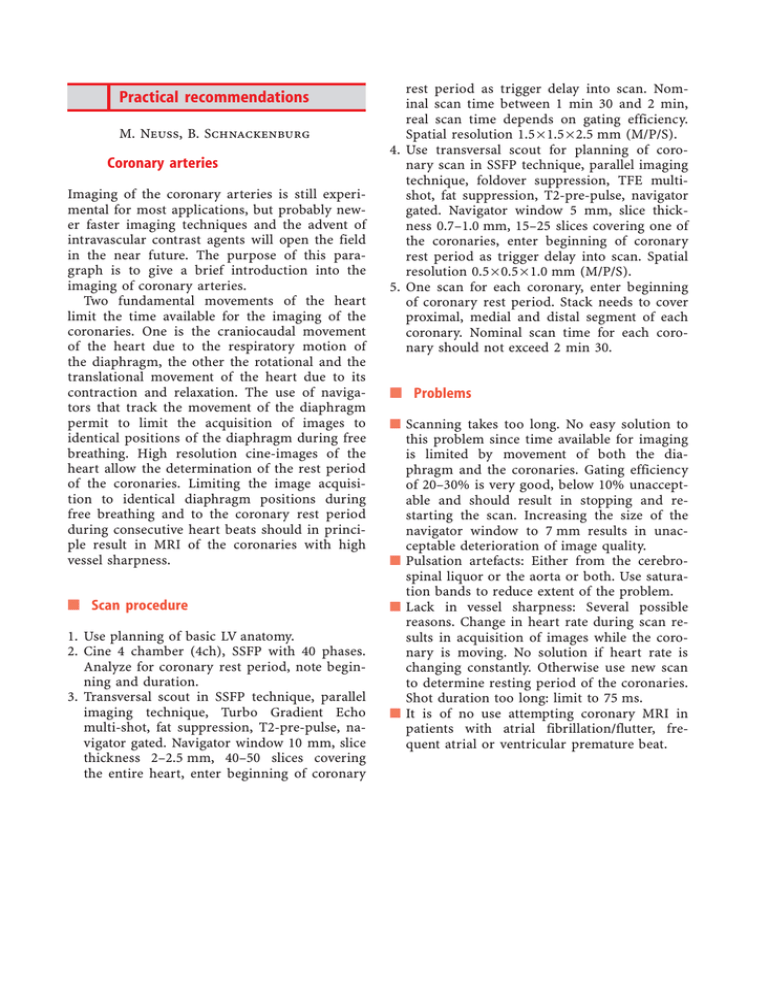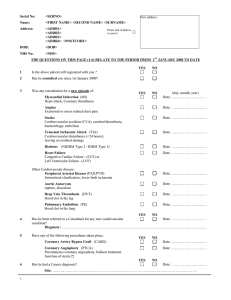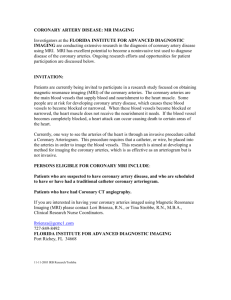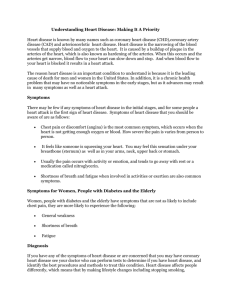Practical recommendations
advertisement

Practical recommendations M. Neuss, B. Schnackenburg Coronary arteries Imaging of the coronary arteries is still experimental for most applications, but probably newer faster imaging techniques and the advent of intravascular contrast agents will open the field in the near future. The purpose of this paragraph is to give a brief introduction into the imaging of coronary arteries. Two fundamental movements of the heart limit the time available for the imaging of the coronaries. One is the craniocaudal movement of the heart due to the respiratory motion of the diaphragm, the other the rotational and the translational movement of the heart due to its contraction and relaxation. The use of navigators that track the movement of the diaphragm permit to limit the acquisition of images to identical positions of the diaphragm during free breathing. High resolution cine-images of the heart allow the determination of the rest period of the coronaries. Limiting the image acquisition to identical diaphragm positions during free breathing and to the coronary rest period during consecutive heart beats should in principle result in MRI of the coronaries with high vessel sharpness. n Scan procedure 1. Use planning of basic LV anatomy. 2. Cine 4 chamber (4ch), SSFP with 40 phases. Analyze for coronary rest period, note beginning and duration. 3. Transversal scout in SSFP technique, parallel imaging technique, Turbo Gradient Echo multi-shot, fat suppression, T2-pre-pulse, navigator gated. Navigator window 10 mm, slice thickness 2–2.5 mm, 40–50 slices covering the entire heart, enter beginning of coronary rest period as trigger delay into scan. Nominal scan time between 1 min 30 and 2 min, real scan time depends on gating efficiency. Spatial resolution 1.5 ´ 1.5 ´ 2.5 mm (M/P/S). 4. Use transversal scout for planning of coronary scan in SSFP technique, parallel imaging technique, foldover suppression, TFE multishot, fat suppression, T2-pre-pulse, navigator gated. Navigator window 5 mm, slice thickness 0.7–1.0 mm, 15–25 slices covering one of the coronaries, enter beginning of coronary rest period as trigger delay into scan. Spatial resolution 0.5 ´ 0.5 ´ 1.0 mm (M/P/S). 5. One scan for each coronary, enter beginning of coronary rest period. Stack needs to cover proximal, medial and distal segment of each coronary. Nominal scan time for each coronary should not exceed 2 min 30. n Problems n Scanning takes too long. No easy solution to this problem since time available for imaging is limited by movement of both the diaphragm and the coronaries. Gating efficiency of 20–30% is very good, below 10% unacceptable and should result in stopping and restarting the scan. Increasing the size of the navigator window to 7 mm results in unacceptable deterioration of image quality. n Pulsation artefacts: Either from the cerebrospinal liquor or the aorta or both. Use saturation bands to reduce extent of the problem. n Lack in vessel sharpness: Several possible reasons. Change in heart rate during scan results in acquisition of images while the coronary is moving. No solution if heart rate is changing constantly. Otherwise use new scan to determine resting period of the coronaries. Shot duration too long: limit to 75 ms. n It is of no use attempting coronary MRI in patients with atrial fibrillation/flutter, frequent atrial or ventricular premature beat.





